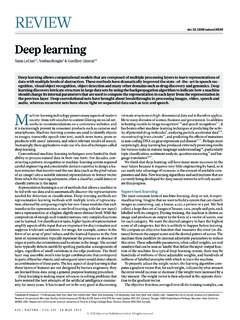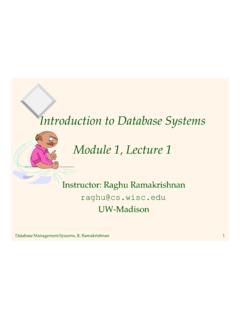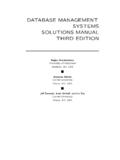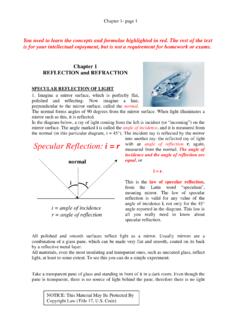Transcription of 1 An Inside Look at Botnets
1 1An Inside look at BotnetsPaul BarfordVinod Sciences DepartmentUniversity of Wisconsin, MadisonAbstractThe continued growth and diversification of the Internet hasbeen accompanied byan increasing prevalence of attacks and intrusions [40]. Itcan be argued, however,that a significant change in motivation for malicious activity has taken place overthe past several years: from vandalism and recognition in the hacker community, toattacks and intrusions for financial gain. This shift has been marked by a growingsophistication in the tools and methods used to conduct attacks, thereby escalatingthe network security arms thesis is that thereactivemethods for network security that are predominanttoday are ultimately insufficient and that moreproactivemethods are required. Onesuch approach is to develop a foundational understanding ofthe mechanisms em-ployed by malicious software (malware) which is often readily available in sourceform on the Internet. While it is well known that large IT security companies main-tain detailed databases of this information, these are not openly available and we arenot aware of any such open repository.
2 In this paper we begin the process of codify-ing the capabilities of malware by dissecting four widely-used Internet Relay Chat(IRC) botnet codebases. Each codebase is classified along seven key dimensionsincluding botnet control mechanisms, host control mechanisms, propagation mech-anisms, exploits, delivery mechanisms, obfuscation and deception mechanisms. Ourstudy reveals the complexity of botnet software, and we discusses implications fordefense strategies based on our IntroductionSoftware for malicious attacks and intrusions (malware) has evolved a great deal overthe past several years. This evolution is driven primarily by the desire of the authors(black hats) to elude improvements in network defense systems and to expand andenhance malware capabilities. The evolution of malcode canbe seen both in termsof variants of existing tools ( ,there are over 580 variants of the Agobot malwaresince it s first release in 2002 [7]) and in the relatively frequent emergence of com-pletely new codebases ( ,there were six major Internet worm families introducedin 2004: Netsky, Bagle, MyDoom, Sassser, Korgo and Witty as well as the Cabirvirus - the first for cell phones [1]).
3 While worm outbreaks and DoS attacks have been widely reported in the pop-ular press and evaluated extensively by the network and security research commu-nities ( ,[16, 27 29]), perhaps the most serious threat to the Internet today arecollections of compromised systems that can be controlled by a single person. Thesebotnetshave actually been in existence for quite some time and tracetheir roots tothe Eggdrop bot created by Jeff Fisher for benign network management in level overviews of malicious botnet history and their basic functionality canbe found in [11, 31]. Over the years botnet capability has increased substantially tothe point of blurring the lines between traditional categories of malware. There havebeen numerous reports of Botnets of over one hundred thousand systems (althoughthe average size appears to be dropping) and the total numberof estimated systemsused in Botnets today is in the millions [17, 19, 23].A plausible reason for the rise of malicious Botnets is that the basic motivationsfor malicious activity are shifting.
4 In the past, the primary motivations for attacksappear to have been simple (but potent) script kiddie vandalism and demonstra-tions of programming prowess in the black hat community. However, there are anincreasing number of reports of for-profit malicious activity including identity theftand extortion that may be backed by organized crime ( ,[2, 35, 37]). This trendtoward an economic motivation is likely to catalyze development of new capabilitiesin botnet code making the task of securing networks against this threat much thesis for our work is that effective network security inthe future will bebased on detailed understanding of the mechanisms used by malware. While thishigh level statement does not represent a significant departure from what has been themodus operandi of the IT security industry for some time, unfortunately, data sharingbetween industry and research to date has not been common. Weargue that greateropenness and more detailed evaluations of the mechanisms ofmalware are requiredacross the network security research community.
5 In some respects this broadens theInternet Center for Disease Control vision outlined by Stanifordet [34]. Weadvocate analysis that includes both static inspection of malware source code whenit is available and dynamic profiling of malware executablesin a controlled environ-ment. An argument for the basic feasibility of this approachis that a good deal ofmalware is, in fact, available on line ( ,[26]) and there are emerging laboratoryenvironments such as WAIL [10] and DETER [15] that enable safe evaluation of ex-ecutables. It is important to emphasize that these analysesare meant tocomplementthe ongoing empirical measurement-based studies ( ,[9, 30, 36]) which provideimportant insight on how malware behaves in the wild, and arecritical in identifyingnew instances of outbreaks and paper presents a first step in the process of codificationof malware mech-anisms. In particular, we present an initial breakdown of four of the major botnetsource codebases including Agobot, SDBot, SpyBot and GT Bot.
6 We conduct thisanalysis by creating a taxonomy of seven key mechanisms and then describe theassociated capabilities for specific instances of each bot family. Our taxonomy em-phasizes botnet architecture, control mechanisms, and methods for propagation andattack. Our objectives are to highlight the richness and diversity of each codebase, toidentify commonalities between codebases and to consider how knowledge of thesemechanisms can lead to development of more effective defense summary of our findings and their implications are as follows: Finding:The overall architecture and implementation of Botnets is complex, andis evolving toward the use of common software engineering techniques such :The regularization of botnet architecture provides in-sight on potential extensibility and could help to facilitate systematic evaluationof botnet code in the future. Finding:The predominant remote control mechanism for Botnets remains Inter-net Relay Chat (IRC) and in general includes a rich set of commands enabling awide range of :Monitors of botnet activity on IRC channels anddisruption of specific channels on IRC servers should continue to be an effectivedefensive strategy for the time being.
7 Finding:The host control mechanisms used for harvesting sensitive informa-tion from host systems are ingenious and enable data from passwords to mailinglists to credit card numbers to be :This is one of the mostserious results of our study and suggests design objectivesfor future operatingsystems and applications that deal with sensitive data. Finding:There is a wide diversity of exploits for infecting target systems writteninto botnet codebases including many of those used by worms that target wellknown Microsoft :This is yet additional evidencethat keeping OS patches up to date is essential and also informs requirements fornetwork intrusion detection and prevention systems. Finding:All Botnets include denial of service (DoS) attack :The specific DoS mechanisms in Botnets can inform designs forfuture DoSdefense architectures. Finding:Shell encoding and packing mechanisms that can enable attacks to cir-cumvent defensive systems are common. However, Agobot is the only botnetcodebase that includes support for (limited) :A sig-nificant focus on methods for detecting polymorphic attacksmay not be war-ranted at this time but encodings will continue to present a challenge for defen-sive systems.
8 Finding:All Botnets include a variety of sophisticated mechanisms for avoidingdetection ( ,by anti-virus software) once installed on a host :Development of methods for detecting and disinfecting compromisedsystems will need to keep pace. Finding:There are at present only a limited set of propagation mechanisms avail-able in Botnets with Agobot showing the widest variety. Simple horizontal andvertical scanning are the most common :The specificpropagation methods used in these Botnets can form the basisfor modeling andsimulating botnet propagation in research remainder of this paper is structured as follows. While there have been rela-tively few studies of Botnets in the research literature to date, we discuss other relatedwork in Section In Section we present our taxonomy ofbotnet code and theresults of evaluating four instances of botnet source Section we summa-rize our work and comment on our next Related WorkEmpirical studies have been one of the most important sources of information onmalicious activity for some time.
9 Mooreet the Code Red I/II wormoutbreaks in [29] and the Sapphire/Slammer worm outbreak [27] providing key de-tails on propagation methods and infection rates. Recently, Kumaret how abroad range of details of the Witty worm outbreak can be inferred using informationabout that malware s random number generator [24]. In [40],firewall and intrusiondetection system logs collected from sites distributed throughout the Internet areused to characterize global attack activity. Several recent studies have demonstratedthe utility of unused address space monitors (honeynets) [21] that include active re-sponse capability as a means for gathering details on network attacks [9, 30, 39].Honeynet measurement studies have also provided valuable information on botnetactivity [18, 39]. Cookeet the potential of correlating data from multi-ple sources as a means for detecting the botnet command and control traffic in [12].Finally, the virtual honeyfarm capabilities described in [38] could prove to be veryuseful for botnet tracking in the we advocated in the prior section, another way to study malware is to gatherand then decompose instances of both source code (many instances of malwaresource code can be found by searching the Web and Usenet news groups) and ex-ecutable code (executables can be gathered by enhancing honeynet environments).
10 There are standard tools available for reverse engineeringexecutables including dis-assemblers, debuggers and system monitors such as [4 6]. Despite the capabilitiesof these tools, the complexity and deception techniques of certain instances of mal-ware executables often complicate this analysis [3]. Likewise, there are many toolsavailable for static analysis of source code such as [13, 14]. While these tools areoften focused on the problems of identifying run time errorsand security vulnerabil-ities, the general information they provide such as parse trees, symbol tables and callgraphs could be valuable in our malware analysis. While we present a simple taxon-omy of malware mechanisms in this paper, we look forward to using both static anddynamic analysis tools for in depth study in the EvaluationOur process of codification of malware begins with a comparison of four botnetfamilies: Agobot, SDBot, SpyBot and GT Bot. These were selected based on theage of their first known instances, the diversity in their design and capabilities, andreports in the popular press, commercial and research communities identifying theseas the most commonly used bot families.



















